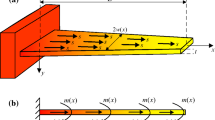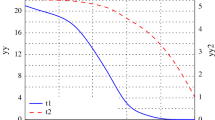Abstract
The competition between the adhesive force and the beam restoring force determines the stiction shape of a microbeam. The presence of residual stress changes the beam stiffness and thus leads to the change of the beam restoring force. This study presents a model of incorporating the residual stress effect for the beam stiction. The previous models of arc-shape and S-shape correspond to the zero residual stress case, which also prescribes the stiction shape. When the residual stress becomes large, arc-shape and S-shape significantly deviate from the actual stiction shape of a slender beam. With the assumed stiction shape of arc-shape and S-shape, suspension length is the only parameter needed to characterize the stiction shape and suspension length can also be used to uniquely determine the adhesion energy. However, there are infinite combinations of residual stress and adhesion energy which can result in the same suspension length. Besides suspension length, the beam rise above the substrate can also be used as a parameter to characterize the stiction shape. This study presents a method of using these two parameters to uniquely determine the residual stress and adhesion energy as an inverse problem. A computation technique of using the stiction shape symmetry to significantly reduce the computation is also demonstrated.







Similar content being viewed by others
References
Biot MA (1937) Bending of an infinite beam on an elastic foundation. ASME J Appl Mech 4:1–7
Castillo J, Barber JS (1997) Lateral contact of slender prismatic bodies. Proc R Soc Lond A 453:2397–2412
Chajes A (1974) Principles of structural stability theory. Prentice-Hall, New Jersey
Chen RS, Baughn TV, Yao Z, Goldsmit CL (2002) A new in-situ residual stress measurement method for a MEMS thin fixed-fixed structure. J Microelectromech Syst 11:309–316
de Boer MP, Michalske TA (1999) Accurate method for determining adhesion of cantilever beams. J Appl Phys 86:817–827
de Boer MP, Knapp JA, Mayer TM, Michalske TA (1999) The role of interfacial properties on MEMS performance and reliability. Proc SPIE 3825:2–15
DelRio F, de Boer MP, Knapps JA, Reedy E Jr, Clews P, Dunn M (2005) The role of van der Waals forces in adhesion of micomachined surfaces. Nature Mat 4:629–634
DelRio F, Dunn ML, Boyce BL, Corwin AD, de Boer MP (2006) The effect of nanoparticles on rough surface adhesion. J Appl Phys 99:104304
Ghatak A, Mahadevan L, Chung JY, Chaudhury MK, Shenoy V (2004) Peeling from a biomimetically patterned thin elastic film. Proc R Soc Lond A 460:2725–2735
Ghatak A, Mahadevan L, Chaudhury MK (2005) Measuring the work of adhesion between a soft confined film and a flexible plate. Langmuir 21:1277–1281
Jensen BD, de Boer MP, Masters ND, Bitsie FD, LaVan A (2001) Interferometry of actuated microcantilevers to determine material properties and test structure nonidealities in MEMS. J Microelectromech Syst 10:336–346
Jiang H, Sun Y, Rogers JA, Huang Y (2008) Post-buckling analysis for the precisely controlled buckling of thin film encapsulated by elastomeric substrate. Int J Solids Struct 45:2014–2023
Jones EE, Begley MR, Murphy KD (2003) Adhesion of micro-cantilever subjected to mechanical point loading: modeling and experiments. J Mech Phys Solids 51:1601–1622
Kerr AD (1976) On the derivation of well posed boundary value problems in structural mechanics. Int J Solids Struct 12:1–11
Knapp JA, de Boer MP (2002) Mechanics of microcantilever beams subjected to combined electrostatic and adhesive forces. J Microelectromech Syst 11:754–764
Komaragiri U, Begley MR, Simmonds JG (2005) The mechanical response of freestanding circular elastic films under point and pressure loads. ASME J Appl Mech 72:203–212
Legtenberg R, Tilmans T, Elders J, Elwenspoek M (1994) Stiction of surface micromachined structures after rinsing and drying: model and investigation of adhesion mechanisms. Sens Actuators A 43:230–238
Leseman ZC, Carlson SP, Mackin TJ (2007) Experimental measurements of the strain energy release rate for stiction-failed microcantilevers using a single-cantilever beam peel test. J Microelectromech Syst 16:38–43
Li GH, Laboriante I, Liu F, Shavezipur M, Bush B, Carraro C, Maboudian R (2010) Measurement of adhesion forces between polycrystalline silicon surfaces via a MEMS double-clamped beam test structure. J Micromech Microeng 20:095015
Lin L, Adams GG (1987) Beam on tensionless elastic foundation. J Eng Mech 113:542–553
Liu JL (2010) Theoretical analysis on capillary adhesion of microsized plates with a substrate. Acta Mech Sin 26:217–223
Loh OY, Espinosa HD (2012) Nanoelectromechanical contact switches. Nature Nanotech 7:283–295
Maboudian R, Howe RT (1997) Critical review: adhesion in surface micromechanical structures. J Vac Sci Technol B 15:1–20
Majidi CS, Adams GG (2009) A simplified formulation of adhesion problems with elastic plates. Proc R Soc Lond A 465:2217–2230
Majidi CS, Fearing RS (2008) Adhesion of an elastic plate to a sphere. Proc R Soc Lond A 464:1309–1317
Majidi CS, Groff RE, Fearing RS (2005) Attachment of fiber array adhesive through side contact. J Appl Phys 98:103521
Mastrangelo CH, Hsu CH (1993a) Mechanical stability and adhesion of microstructures under capillary forces-part I: basic theory. J Microelectromech Syst 2:33–43
Mastrangelo CH, Hsu CH (1993b) Mechanical stability and adhesion of microstructures under capillary forces-part II: experiments. J Microelectromech Syst 2:44–55
Obreimoff JW (1930) The splitting strength of mica. Proc R Soc Lond A 127:290–297
Press WH, Teukolsky SA, Vetterling WT, Flannery BP (1992) Numerical recipes in fortran, 2nd edn, chap.9. Cambridge University Press, Cambridge
Rogers JW, Mackin TJ, Phinney LM (2002) A thermomechanical model for adhesion reduction of MEMS cantilevers. J Microelectromech Syst 11:512–520
Tayebi N, Polycarpou AA (2006) Adhesion and contact modeling and experiments in microelectromechanical systems including roughness effects. Microsyst Technol 12:854–869
van Spengen WM, Puers R, Mertents R, De Wolf I (2004) Characterization and failure analysis of MEMS: high resolution optical investigation of small out-of-plane movements and fast vibrations. Microsyst Technol 10:89–96
Vlassak JJ, Nix WD (1992) A new bulge test for the determination of Young’s modulus and Poisson’s ratio of thin film. J Mater Res 7:3242–3249
Wei Z, Zhao YP (2007) Growth of liquid bridge in AFM. J Phys D Appl Phys 40:4368–4375
Weitsman Y (1970) On foundations that reacts in compression only. ASME J Appl Mech 37:1019–1030
Wong MF, Duan G, Wan KT (2007) Adhesion-delamination mechanics of a prestressed rectangular film adhered onto a rigid substrate. J Appl Phys 101:024903
Wu L, Noels L, Rochus V, Pustan M, Golinval JC (2011) A micro-macroapproach to predict stiction due to surface contact in microelectromechanical systems. J Microelectromech Syst 20:976–990
Wu L, Golinval JC, Noels L (2013) A micro-model for elasto-plastic adhesive-contact in micro-switches: application to cyclic loading. Tribol Int 57:137–146
Yang F (2004) Contact deformation of a micromechanical structure. J Micromech Microeng 14:263–268
Yang F (2006) Electromechanical contact of microelectromechanical structure. J Appl Phys 100:124511
Yee Y, Park M, Chun K (2002) A sticking model of suspended polysilicon microstructure including residual stress gradient and postrelease temperature. J Microelectromech Syst 11:754–764
Zhang Y (2008) Tensionless contact of a finite beam resting on Reissner foundation. Int J Mech Sci 50:1035–1041
Zhang Y, Murphy KD (2004) Response of a finite beam in contact with a tensionless foundation under symmetric and asymmetric loading. Int J Solids Struct 41:6745–6758
Zhang Y, Zhao YP (2004) Static study of cantilever beam stiction and electrostatic force influence. Acta Mech Solida Sin 17:104–112
Zhang Y, Zhao YP (2006) An effective method of determining the residual stress gradients in a micro-cantilever. Microsyst Technol 12:357–364
Zhang Y, Zhao YP (2011) A precise model for the shape of an adhered microcantilever. Sens. Actuators A 171:381–390
Zhang Y, Zhao YP (2012) Flexural contact in MEMS stiction. Int J Solids Struct 49:2203–2214
Zhao YP, Wang LS, Yu TX (2003) Mechanics of adhesion in MEMS- a review. J Adhes Sci Tech 17:519–546
Acknowledgments
The research has been supported by the National Natural Science Foundation of China (NSFC Nos. 11023001 and 11372321).
Author information
Authors and Affiliations
Corresponding author
Appendix: arc-shaped and S-shaped deflections
Appendix: arc-shaped and S-shaped deflections
Figure 1b shows the arc-shape and S-shaped deflections and the coordinate system. When a beam is under stiction with no transverse and axial loads, the following governing equation holds:
The solution to the above equation is
\(A\), \(B\), \(C\) and \(D\) are the four unknown constants to be determined by the boundary conditions.
For an arc-shaped beam, the following boundary conditions hold:
\(w(\xi )\) of arc-shaped beam is then solved as follows
The (dimensional) suspension length of arc-shaped beam is given as follows (Mastrangelo and Hsu 1993b; Yang 2004)
According to the nondimensionalization scheme of Eq. (4), we have \(s_{arc}=\beta S_{arc}=\root 4 \of {9h^2/\alpha }\).
For an S-shaped beam, the following boundary conditions hold:
\(w(\xi )\) of S-shaped beam is solved as follows
The (dimensional) suspension length of S-shaped beam is given by Yang (2004) as follows
The dimensionless \(s_{c-c}=\beta S_{c-c}=\root 4 \of {36h^2/\alpha _r}\) and \(s_{arc}=\frac{\sqrt{2}}{2}s_{c-c}\). Equations (21) and (24) are also presented by de Boer et al. (1999). As the two coordinate systems in Fig. 1a and b are different, Eqs. (21) and (24) are the following forms in the coordinate system of Fig. 1a
Rights and permissions
About this article
Cite this article
Zhang, Y., Zhao, YP. Determining both adhesion energy and residual stress by measuring the stiction shape of a microbeam. Microsyst Technol 21, 919–929 (2015). https://doi.org/10.1007/s00542-014-2127-6
Received:
Accepted:
Published:
Issue Date:
DOI: https://doi.org/10.1007/s00542-014-2127-6




